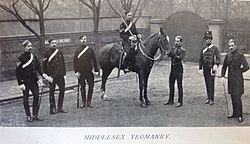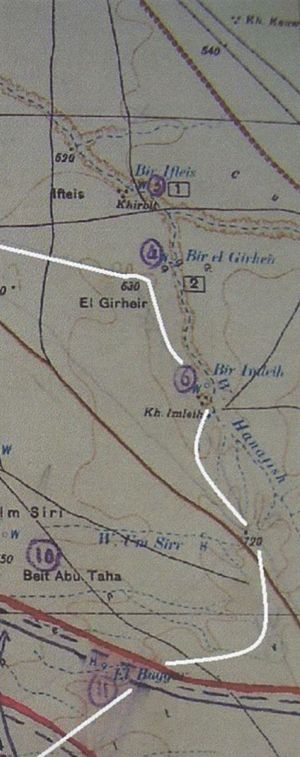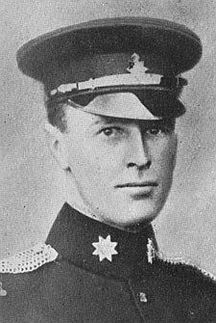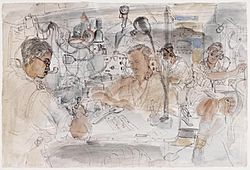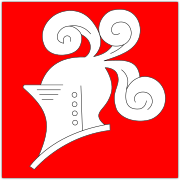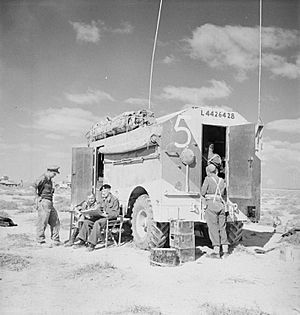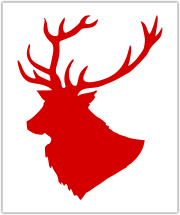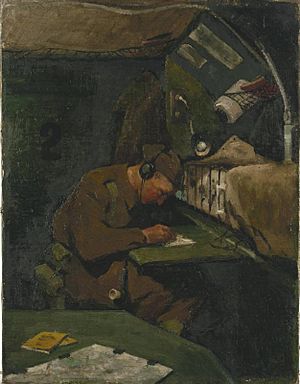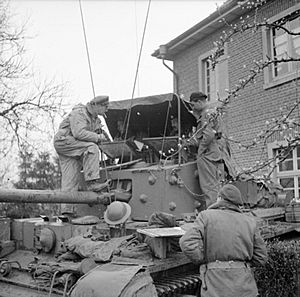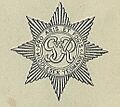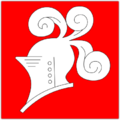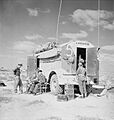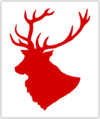Middlesex Yeomanry facts for kids
Quick facts for kids Middlesex Yeomanry |
|
|---|---|
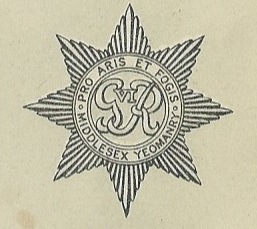
Middlesex Yeomanry badge (reign of King George VI)
|
|
| Active | 1797–1802 1830–present |
| Country | |
| Branch | |
| Size | 3 Regiments (First World War) 2 Signal units (Second World War) Squadron (current) |
| Motto(s) | "Pro Aris et Focis" (For Hearth and Home) |
| Anniversaries | Lafone Day (27 October) |
| Engagements | Second Boer War:
|
| Battle honours | See Battle honours below |
| Commanders | |
| Honorary Colonel | Colonel Simon G. Hutchinson, MBE |
| Notable commanders |
Sir Christopher Baynes, 1st Baronet Lt-Col Hon Somerset Maxwell, MP Lt-Col Viscount Malden |
The Middlesex Yeomanry was a volunteer cavalry regiment of the British Army. It was first formed in 1797. This group of soldiers fought in the Second Boer War and the First World War. They saw action in places like Gallipoli and Palestine. During the First World War, one of their officers won a special bravery award called the Victoria Cross. The regiment even rode into Damascus with the famous 'Lawrence of Arabia'.
Between the two World Wars, the regiment changed its role. It became a "signals" unit, which means they handled communications. In the Second World War, they provided important radio and other communications for large tank armies. They served in many places, including the Western Desert and North-West Europe. Today, their history is carried on by 31 (Middlesex Yeomanry and Princess Louise's Kensington) Signal Squadron, which is part of the Army Reserve.
Contents
How the Middlesex Yeomanry Started
In 1793, the Prime Minister, William Pitt the Younger, suggested that counties in England should create volunteer cavalry groups. These groups, called "Yeomanry Cavalry," would help defend the country if it was invaded. They could also help keep peace if there were riots.
Early Days and First Formations
A cavalry group called the Uxbridge Volunteer Cavalry was started in 1797. It was led by Christopher Baynes. By 1798, this unit had over 100 men. They were called out once in 1801 to stop riots. After a peace treaty in 1802, the group was disbanded.
However, due to more unrest, two new Yeomanry groups were formed in the Uxbridge area in 1830. This new unit was called the Uxbridge Squadron of Yeomanry Cavalry. In 1834, they even escorted King William IV when he visited a nobleman. The unit was called out a few more times, but they never had to fight.
Becoming the Middlesex Yeomanry Cavalry
The Uxbridge Squadron changed its name to the Middlesex Yeomanry Cavalry in 1838. It had different troops (smaller groups of soldiers) in London, Uxbridge, and West Middlesex.
By the 1880s, the regiment's main office (HQ) moved to London.
The regiment changed its name again in 1884 to the Middlesex (Duke of Cambridge's Hussars) Yeomanry Cavalry. This name honored Prince George, Duke of Cambridge, who was a very important military leader at the time.
Serving in the Second Boer War
In late 1899, during the Second Boer War in South Africa, the British government needed more soldiers, especially mounted ones. On December 24, 1899, a special order created the Imperial Yeomanry (IY). These were volunteer groups of about 115 men who would serve for one year. They were trained to fight on horseback.
Middlesex Companies in South Africa
The Middlesex Yeomanry quickly formed three companies for the Imperial Yeomanry: the 34th, 35th, and 62nd (Middlesex) Companies. They arrived in South Africa in early 1900. In 1901, they raised another company, the 112th (Middlesex) Company.
In May 1900, the 11th Battalion IY, which included Middlesex Yeomanry soldiers, was part of a larger British force. On May 25, Major Henry Dalbiac and his 34th (Middlesex) Company entered the town of Senekal. The Boers attacked later that day, and Major Dalbiac was killed.
The Battle of Groenkop
The war continued with the British trying to control the Boer fighters. In December 1901, a group of 400 Yeomanry soldiers, including the 11th Battalion IY, camped on a hill called Groenkop. They were not well-protected. At 2:00 AM on Christmas morning, the Boers attacked. They surprised the camp in the dark.
In the Battle of Groenkop, almost 350 out of 550 men were killed or captured. The Boers took supplies from the camp. This was the Boers' last big success. The war ended in April 1902. For their bravery, the Middlesex IY companies earned their first special honor: South Africa 1900–01.
After the war, the Yeomanry regiments at home were changed into Imperial Yeomanry. The Middlesex unit became the Middlesex Imperial Yeomanry (Duke of Cambridge's Hussars) in 1901. In 1908, it became part of the new Territorial Force (TF) and was named the 1st County of London Yeomanry (Middlesex, Duke of Cambridge's Hussars).
The First World War (1914-1918)
When World War I began in August 1914, the Territorial Force was meant for home defense. However, many soldiers volunteered to serve overseas. So, the units were split into "1st Line" (for overseas service) and "2nd Line" (for home service). A "3rd Line" was later formed to train new soldiers.
1st Line: Fighting Overseas
The 1st Line regiment, called the 1/1st County of London Yeomanry, was sent to Egypt in April 1915.
Gallipoli Campaign
In August 1915, the regiment was ordered to fight in the Gallipoli Campaign in Turkey. They left their horses behind and landed at Suvla Bay on August 18. On August 21, they were ordered to attack Turkish positions on the W Hills. The advance was very dangerous, and they faced heavy fire. They managed to capture part of a hill, but many soldiers were killed or wounded. This was the Battle of Scimitar Hill.
The Middlesex Yeomanry suffered many casualties. By September 4, they were so weak that their brigade was combined into a single unit called the 4th London Regiment of Yeomanry. By November 1, they had fewer than 50 men left. They were sent to Egypt to recover.
Fighting in Salonika
In November 1916, the regiment was sent to the Macedonian front in Greece, near the city of Salonika. Here, they sometimes rode out at night into "no man's land" to set up barbed wire defenses.
The Palestine Front
In June 1917, the regiment moved to the Palestine Front. They joined the Yeomanry Mounted Division in the Egyptian Expeditionary Force (EEF).
On October 27, 1917, a Middlesex Yeomanry outpost on Point 630 was attacked by a large Ottoman (Turkish) cavalry force. This started the Battle of Buqqar Ridge. The Yeomanry soldiers fought bravely, even though they were greatly outnumbered. They held their ground against 20-to-1 odds.
Another post, Point 720, was held by two troops led by Major Alexander Malins Lafone. They were attacked by many Ottoman cavalry and machine guns. After six hours, almost all the Yeomanry on Hill 720 were killed. Major Lafone was given the Victoria Cross (VC) after his death for his courage in encouraging his men to fight.
On October 31, 1917, the EEF launched a new attack, the Third Battle of Gaza. The Yeomanry took part in the pursuit towards Jerusalem. They fought in the battles of Mughar Ridge and Nebi Samwil. Jerusalem surrendered on December 9.
The Final Push to Damascus
In March 1918, many British units were sent from Palestine to the Western Front in France. The Yeomanry Division was changed, and the Middlesex Yeomanry became part of the 11th Cavalry Brigade.
The EEF launched its final attack, the Battle of Megiddo, on September 19, 1918. The cavalry moved very quickly, riding 70 miles in 34 hours. They captured the German-Turkish headquarters at Afulah and Beisan, cutting off Turkish escape routes.
On September 30, the 11th Brigade joined T.E. Lawrence and his Arab fighters. The Middlesex Yeomanry and other units helped trap the Turkish rearguard. Damascus fell the next morning. The war in the Middle East ended a month later.
2nd Line: Home Service and Cyclists
The 2nd Line regiment was formed in Chelsea in 1914. By 1916, it was changed into a cyclist unit. This meant the soldiers rode bicycles instead of horses. They were based in Norfolk, England. In 1918, the regiment moved to Ireland and stayed there until the end of the war.
3rd Line: Training New Soldiers
The 3rd Line regiment was formed in April 1915. Its job was to train new soldiers to replace those fighting in the 1st and 2nd Line units.
Between the World Wars
After World War I, there were too many cavalry units. The Middlesex Yeomanry made a unique choice: they decided to become a "signal unit." This meant they would focus on communications. They joined the new Royal Corps of Signals in 1920. Their new name was 2nd Cavalry Divisional Signals (Middlesex Yeomanry).
In the late 1930s, the British Army started using more machines like tanks. The Middlesex Yeomanry became Mobile Divisional Signals (Middlesex Yeomanry) in 1938. When the army grew bigger, they formed a second unit. Soon after, they became 1st and 2nd (Middlesex Yeomanry) Armoured Divisional Signals.
The Second World War (1939-1945)
1st Cavalry Divisional Signals
At the start of World War II, the first unit became 1st Cavalry Divisional Signals (Middlesex Yeomanry). They provided communications for the 1st Cavalry Division. They moved to Palestine in January 1940.
'Kingcol' and Iraq
In April 1941, there was a coup in Iraq, and a British air base came under attack. A relief force called 'Habforce' was put together. A fast-moving part of this force, called 'Kingcol', included Middlesex Yeomanry signals. They crossed the desert in very hot weather, often digging out heavy vehicles. They were also attacked by German planes.
Kingcol reached the airbase on May 18. They then attacked Fallujah and captured a bridge. After driving off an Iraqi counter-attack, Kingcol advanced on Baghdad. The Iraqis asked for a ceasefire on May 30.
In June, Habforce joined the fight against French forces in Syria. The Middlesex Yeomanry signals helped with communications during these tough campaigns.
9th Armoured Brigade Signals
In August 1941, the 1st Cavalry Division became the 10th Armoured Division. The 4th Cavalry Brigade became the 9th Armoured Brigade. The Middlesex Yeomanry provided the 9th Armoured Brigade Signal Squadron.
Persia
The 9th Armoured Brigade was sent to take part in the Anglo-Soviet invasion of Iran. They advanced into Persia, and the pro-Axis Persian government fell. The brigade then returned to Palestine.
The Battle of El Alamein
In 1942, the 9th Armoured Brigade was sent to Libya and Egypt. It was assigned to support the 2nd New Zealand Division in the Second Battle of El Alamein. This was a very important battle.
On October 23, the 9th Armoured Brigade faced strong resistance and minefields. They lost many tanks but tried to hold their ground. After the battle, they pursued the defeated Axis forces. By early 1943, they were back in Syria.
Fighting in Italy
The 9th Armoured Brigade joined the Eighth Army in Italy in May 1944. They fought in the Battle of Lake Trasimeno and advanced towards Florence. They also helped break through the Gothic Line.
Later, the brigade was chosen to lead the crossing of the River Po. This involved special amphibious tanks. The crossing began on April 23, 1945. German forces in Italy surrendered on May 2. The brigade was then chosen for operations in the Far East, but the war ended before they could go.
2nd Armoured Divisional Signals
The second Middlesex Yeomanry unit joined the 2nd Armoured Division in March 1940. After the Dunkirk evacuation, this division was the only armored group ready to defend Britain from invasion.
However, the division was sent to the Middle East to fight the Italians. They arrived in Egypt in January 1941.
In February, parts of the division were sent to Cyrenaica in Libya. On March 31, the 2nd Armoured Division faced a German counter-attack led by Gen Erwin Rommel. The fighting was very confusing. On April 7, many soldiers from the 2nd Armoured Division HQ and Signals were captured at Mechili.
22nd Armoured Brigade Signals
The 22nd Armoured Brigade and its signal squadron stayed in the UK at first. They arrived in Egypt in October 1941.
North Africa and Italy
The brigade fought in the rest of the Western Desert Campaign, including the Relief of Tobruk and the battles of Gazala and First Alamein. After the Second Battle of El Alamein, the brigade became a permanent part of the 7th Armoured Division.
They served through the Tunisian Campaign and then took part in the landings at Salerno in Italy. They advanced on Naples before returning to the UK in January 1944.
Normandy and Beyond
In 1944, the 22nd Armoured Brigade was re-equipped for the Allied landings in Normandy. They landed on Gold Beach on June 7. They faced tough fighting in the Bocage country and at the Battle of Villers Bocage.
After breaking out from the Normandy beachhead, the division advanced quickly across northern France and Belgium. They helped liberate towns like Ghent.
In 1945, they prepared for the crossing of the Rhine River, called Operation Plunder. After the infantry crossed, the 7th Armoured Division followed. They advanced quickly, covering 120 miles by April 2. Hamburg surrendered to the 7th Armoured Division on May 3, and the war in Europe ended soon after.
After the War
After World War II, the unit was reformed. In 1947, it became 16th Airborne Divisional Signal Regiment (Middlesex Yeomanry). This meant they were part of an airborne (parachute) division.
Over the years, the unit's name and structure changed several times as the army was reorganized. In 1961, it joined with another signal regiment to form 47 Signal Regiment (Middlesex Yeomanry). In 1967, it was reduced to a squadron, becoming 47 (Middlesex Yeomanry) Signal Squadron.
The squadron moved between different regiments over the years. In 2014, it joined with another squadron to form the current 31 (Middlesex Yeomanry and Princess Louise's Kensington) Signal Squadron.
Uniforms and Badges
The Middlesex Yeomanry wore many different uniforms over their history.
Early Uniforms
In 1830, their uniform included a green coat with black trim and brass buttons. They wore dark blue trousers with red stripes. Their hat was a tall shako with a black feather. In 1872, they adopted a "Hussar" uniform, which was a fancy style of cavalry uniform. They wore dark green jackets with black trim and dark blue trousers with red stripes. Their hat was a tall, furry "Busby" with a green bag and feather.
Khaki and Modern Uniforms
After the Second Boer War, they started wearing khaki uniforms. These were more practical for fighting. They wore slouch hats, which were wide-brimmed hats. By 1907, they adopted service caps. After World War I began, the khaki service uniform became the standard.
When the Middlesex Yeomanry became a Royal Signals unit, they kept their old cap badge. They also wore the Royal Corps of Signals shoulder badge with a 'Y' above it to show they were Yeomanry. During World War II, they wore the badge of their larger army formation on their shoulder.
Today, the 47 (Middlesex Yeomanry) Signal Squadron wears a special lanyard of green and gold parachute cord. This remembers their time as airborne signals. They also keep the Middlesex Yeomanry collar badges and buttons.
Commanders and Leaders
Many officers have led the Middlesex Yeomanry over the years.
Commanding Officers
- Sir Christopher Baynes, Bt (Uxbridge Volunteer Cavalry)
- Lt-Col Hubert de Burgh (Middlesex Yeomanry, 1831)
- Lt-Col W.H. Mitford (Middlesex Yeomanry, 1892)
- Maj W.D. Marcuse (2nd Cavalry Divisional Signals, 1920)
- Lt-Col Hon S.A. Maxwell, MP (1st Cavalry Divisional Signals, 1941–42)
- Lt-Col B.B. Kennett, MBE (2nd Armoured Divisional Signals, 1940–41)
- Lt-Col Viscount Malden, TD (16th Airborne Divisional Signals, 1947)
Honorary Colonels
These officers held a special honorary role in the unit:
- Frederick Cox (appointed 1878)
- FM The Duke of Cambridge (appointed 1894)
- FM Earl Kitchener of Khartoum (appointed 1910)
- Maj H.D. Roberts, MC, TD (appointed 1935)
- Lt-Col Reginald Capell, Viscount Malden (appointed 1957)
Special Honors
Victoria Crosses
Major Alexander Malins Lafone was awarded a Victoria Cross (VC) after his death for his incredible bravery at the Battle of el Buqqar Ridge (as mentioned above).
Another officer, Major Oliver Cyril Spencer Watson, also won a VC. He had served with the Middlesex Yeomanry at Gallipoli. Later, while commanding another battalion on the Western Front in France, he won a VC for leading a counter-attack on March 28, 1918. He has no known grave. The Middlesex Yeomanry is proud to claim two of the three Victoria Crosses ever awarded to the Yeomanry as a whole.
Battle Honors
The Middlesex Yeomanry earned special "battle honors" for their bravery in different battles. These honors are kept by the units that continue their history.
| Second Boer War | South Africa 1900–01 |
| First World War | Macedonia 1916–17, Suvla, Scimitar Hill, Gallipoli 1915, Egypt 1915–16, Gaza, El Mughar, Nebi Samwil, Megiddo, Sharon, Damascus, Palestine 1917–18 |
Memorial
The Middlesex Yeomanry has a memorial in the crypt of St Paul's Cathedral in London. It was first unveiled in 1906 to remember the 55 members who died in the Second Boer War. Later, panels were added for those who died in the First and Second World Wars.
The Church of St Martin-within-Ludgate is the regiment's special chapel. Every year, on Lafone Day (October 27), a service and parade start there. They march to St Paul's Cathedral to lay a wreath at the memorial.
Images for kids


